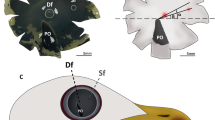Summary
The retina of nudibranch eyes contains two types of large cells; pigment cells which comprise about two-thirds of the total, with unpigmented sensory cells making up the remainder. Both pigment and receptor cells carry microvilli on their distal borders, but no traces of cilia were observed among them. The cornea of the eyes of aeolid and dendronotid nudibranchs is composed of a single layer of small cells, unlike the dorids where the cornea is made up of one of more large cells. The latter contain nuclei comparable in size with those of the pigment cells in the retina, but are themselves unpigmented.
The elliptical eyes ofAplysia contain three types of retinal cell; the pigment cells and two kinds of receptor cells. The “ciliary” receptor cells bear equal numbers of cilia (9+2) and microvilli, while the “microvillous” receptor cells carry long tufts of microvilli with only an occasional cilium among them. The proximal cytoplasm of the receptor cells inAplysia and the nudibranchs contains large quantities of the small spherical vesicles (averaging 660 Å in diameter) which appear to be characteristic of gastropod eyes.
Similar content being viewed by others
References
Alder, J., Hancock, A.: The British nudibranchiate molluscs. Published in 8 parts by the Bay Society in 1909 (1845–1855).
Barber, V. C., Evans, E. M., Land, M. F.: The fine structure of the eye of the molluscPecten maximus. Z. Zellforsch.76, 295–312 (1967).
—, Land, M. F.: Eye of the cockleCardium edule. Experientia (Basel)123, 67 (1967).
—, Wright, D. E.: The fine structure of the eye and optic tentacle of the molluscCardium edule. J. Ultrastruct. Res.26, 515–528 (1969).
Barth, J.: Intracellular recordings obtained from the retinal cells ofHermissenda. Comp. Biochem. Physiol.2, 311–315 (1964).
Boettger, C. R.: Die Systematik der eurthyneuranen Schnecken. Verhandl. der Dtsch. Zool. Ges. Tübingen, ch. 22, 253–80. Leipzig: Akademische Verlagsgesellschaft Geest & Portig K.-G. 1954.
Caulfield, J. B.: Effects of varying the vehicle for OsO4 in tissue fixation. J. biophys. biochem. Cytol.3, 827–829 (1957).
Charles, G. H.: Sense organs of the Mollusca. In: The physiology of the Mollusca, vol.2, 455–480, edit. by K. Wilbur and C. M. Yonge. New York-London: Academic Press 1966.
Clark, A. W.: The fine structure of two invertebrate photoreceptor cells. J. Cell Biol.19, 14A (1963).
Dennis, M. J.: Lateral inhibition in a simple eye. Amer. Zool.5, abst. 109 (1965).
—: Electrophysiology of the visual system in a nudibranch mollusc. J. Neurophysiol.30, 1439–1465 (1967).
Dilly, P. N.: The structure of a photoreceptor organelle in the eye ofPterotrachea mutica. Z. Zellforsch.99, 420–429 (1969).
Dorsett, D. A., Hyde, R.: The fine structure of the lens and photoreceptors ofNereis virens. Z. Zellforsch.85, 243–255 (1968).
Eakin, R. M., Brandenburger, J. L.: Differentiation in the eye of a pulmonate snailHelix aspersa. J. Ultrastruct. Res.18, 391–421 (1967).
—, Westfall, J. A., Dennis, M. J.: Fine structure of the eye of a nudibranch molluscHermissenda crassicornis. J. Cell Sci.2, 349–358 (1967).
Eales, N. B.:Aplysia. L. M. B. C. Mem. typ. Br. mar. Pl. Anim. No.24, 1–78 (1921).
Eloffson, R.: The ultrastructure of the nauplius eye ofSapphirina. Z. Zellforsch.100, 376–401 (1969).
Hartline, H. K.: The discharge of impulses in the optic nerve ofPecten in response to illumination of the eye. J. cell comp. Physiol.11, 465–478 (1938).
Horridge, G.: Presumed photoreceptive cilia in a Ctenophore. Quart. J. micr. Sci.105, 311–317 (1964).
Jacklett, J. W.: Electrophysiological organisation of the eye ofAplysia. J. gen. Physiol.53, 21–42 (1969a).
—: Circadian rhythm of optic nerve impulses recorded in darkness from isolated eye ofAplysia. Science164, 562–563 (1969b).
Miller, W. H.: The fine structure of some invertebrate photoreceptors. Ann. N. Y. Acad. Sci.74, 204–209 (1958).
—: Visual photoreceptor structures. In: The cell, vol.4, p. 325–364, edit. by J. Brachet and A. E. Mirsky. New York, Academic Press 1960.
Millonig, G.: Advantages of a phosphate buffer for osmium tetroxide solutions in fixation. J. appl. Phys.32, 1–37 (1961).
Morton, J. E.: Molluscs. London: Hutchinson University Press 1958.
Newell, G. E.: The eye ofLittorina littorea. Proc. zool. Soc. Lond.144, 75–87 (1965).
Newell, P., Newell, G. E.: The fine structure of a slug eye. Symp. Zool. Soc. Lond. “Invertebrate Receptors”, 1967, in press.
Pelseneer, P.: La rudimentation de l'oeil chez les gastropodes. Ann. Soc. R. Malacol. Belg. (Bull.)23, 1–50 (1888).
—: Recherches sur divers opisthobranches. Mém. cour. sav. étr. Acad. Sci. Belg.53, 1–41 (1893–1894).
Richardson, K. C.: Embedding in epoxy resins for ultrathin sectioning in electron microscopy. Stain Technol.35, 313–330 (1960).
Röhlich., P., Tar, E.: The effect of prolonged light-deprivation on the fine structure of planarian photoreceptors. Z. Zellforseh.90, 507–518 (1968).
—, Török, L. J.: Elektronenmikroskopische Untersuchungen des Auges vonPlanaria. Z. Zellforsch.54, 362–381 (1961).
— —: Die Feinstruktur des Auges der WeinbergschneckeHelix pomatia. Z. Zellforseh.60, 348–368 (1963).
Schwalbach, G., Lickfield, K. G., Hahn, M.: Der mikromorphologische Aufbau des Linsenauges der Weinbergschnecke,Helix pomatia. Protoplasma56, 242–272 (1963).
Tonosaki, A.: Fine structure of the retina ofHaliotis discus. Z. Zellforsch.79, 469–480 (1967).
Willem, V.: Contributions a l'étude physiologique des organes des sens chez les Molluscques (Prosobranches et Opisthobranches) III. Observations sur la vision et les organes visuels de quelques Molluscques. Prosobranches et Opisthobranches. Arch. Biol. (Liegè)12, 123–149 (1892).
Yanase, T., Sakamoto, S.: Fine structure of the visual cells of the dorsal eye in the molluscOnchidium verrulatum. Zool. Mag. (Tokyo)74, 238–242 (1965).
Author information
Authors and Affiliations
Rights and permissions
About this article
Cite this article
Hughes, H.P.I. A light and electron microscope study of some opisthobranch eyes. Z.Zellforsch 106, 79–98 (1970). https://doi.org/10.1007/BF01027719
Received:
Issue Date:
DOI: https://doi.org/10.1007/BF01027719




